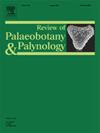捷克Kladno-Rakovník盆地Duckmantian的萼生植物新种
IF 1.7
3区 地球科学
Q2 PALEONTOLOGY
引用次数: 0
摘要
在Kladno-Rakovník盆地的Theodor煤矿的Pchery地区,一个新描述的分类群的小尖状末目羽甲已经被发现得比较普遍。虽然这种植物的叶片碎片已经被发现了一个多世纪,但由于它们具有神经类(小叶尖的脉状和心形基部)和蝶类(小叶尖)的特征,因此尚未被正式鉴定。该分类群与同属萼叶植物目的伪掌叶植物(Pseudomariopteris cordato-ovata)和西掌叶植物(Mariopteris occidentalis)有一定的相似性。然而,Theodor矿山的遗骸没有已知的西方马里蕨的裂片小叶,也没有成熟的cordato-ovata伪马里蕨典型的突出的基叶。尽管如此,这三个物种的角质层表现出一些相似之处,包括正面角质层显示细长的细胞和非常小的毛状基部,以及极延长的气孔。然而,差异也是存在的。来自Theodor Mine的物种具有由桶状细胞形成的小毛状体,而Mariopteris occidentalis具有长达0.5毫米的多细胞毛状体,而Pseudomariopteris cordato-ovata具有树脂体而不是毛状体。表皮结构的总体相似性和针叶形态的差异支持萼生植物目新属和新种的形成。Neuromariopteris scandens gen. et sp. 11 .这个名字暗示了它与类神经翼虫的相似性。这个分类群可能是一种匍匐植物,就像所有的萼生植物一样。该种可能是生长在煤盆地周围的元古代脊坡上的植被元素。这种植物的外来特征可能是由土壤因素造成的。本文章由计算机程序翻译,如有差异,请以英文原文为准。
New callistophytalean species from the Duckmantian of the Kladno-Rakovník Basin, Czech Republic
Small-pinnuled last order pinnae of a newly described taxon have previously been found relatively commonly at the Pchery locality, Theodor Coal Mine, in the Kladno-Rakovník Basin. Although foliar fragments of this plant have been known for over a century, the remains have yet to be formally identified because they share features characteristic of the neuropteroids (venation and cordate base of pinnules) and sphenopteroids (small pinnules). This taxon shows some resemblance to the species Pseudomariopteris cordato-ovata and Mariopteris occidentalis, both belonging to Order Callistophytales. However, the remains from the Theodor Mine do not have the lobed pinnules known for Mariopteris occidentalis, nor the prominent basal lobe typical of mature Pseudomariopteris cordato-ovata. Nonetheless, cuticles of all three of these species demonstrate some similarities, including adaxial cuticles showing elongated cells with very small trichome bases, and stomata with polar prolongation. However, differences also exist. The species from the Theodor Mine has small trichomes formed by barrel-shaped cells, whereas Mariopteris occidentalis has multicellular trichomes up to 0.5 mm long, and Pseudomariopteris cordato-ovata has resin bodies rather than trichomes. The overall similarity of cuticular structures and differences in pinnule morphology support erection of a new genus and species within Order Callistophytales. The name Neuromariopteris scandens gen. et sp. nov. alludes to the similarity to neuropteroids. The taxon probably was a creeping plant, as is known for all callistophytaleans. This species was probably an element of vegetation growing on the Proterozoic ridge slopes surrounding the coal basin. The exotic character of this flora is caused probably by edaphic factors.
求助全文
通过发布文献求助,成功后即可免费获取论文全文。
去求助
来源期刊
CiteScore
3.50
自引率
21.10%
发文量
149
审稿时长
6 months
期刊介绍:
The Review of Palaeobotany and Palynology is an international journal for articles in all fields of palaeobotany and palynology dealing with all groups, ranging from marine palynomorphs to higher land plants. Original contributions and comprehensive review papers should appeal to an international audience. Typical topics include but are not restricted to systematics, evolution, palaeobiology, palaeoecology, biostratigraphy, biochronology, palaeoclimatology, paleogeography, taphonomy, palaeoenvironmental reconstructions, vegetation history, and practical applications of palaeobotany and palynology, e.g. in coal and petroleum geology and archaeology. The journal especially encourages the publication of articles in which palaeobotany and palynology are applied for solving fundamental geological and biological problems as well as innovative and interdisciplinary approaches.

 求助内容:
求助内容: 应助结果提醒方式:
应助结果提醒方式:


